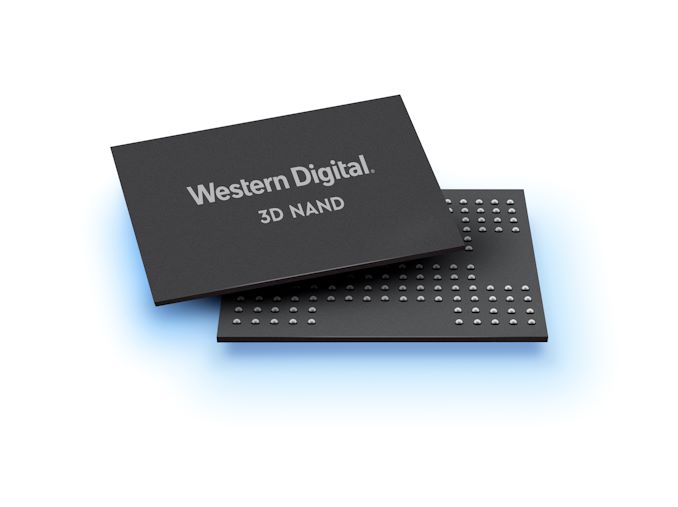Western Digital and Kioxia Announce BiCS5 112-Layer 3D NAND
by Billy Tallis on January 30, 2020 7:20 PM EST
Western Digital and Kioxia have announced the successful development of their newest generation of 3D NAND flash memory. Their fifth-generation BiCS 3D NAND has commenced production in the form of a 512 Gbit TLC part, but will not ramp up to "meaningful commercial volumes" until the second half of the year. Other parts planned for this generation include 1Tbit TLC and 1.33 Tbit QLC dies.
The BiCS5 design uses 112 layers compared to 96 for BiCS4. BiCS5 is the second generation from WDC/Kioxia to be constructed with string stacking, and is probably built as two stacks of about 56 active layers each. Even though 112 layers is only a ~16% increase over the previous generation, the companies are claiming a density increase of up to 40% (comparing 112L 512Gb TLC against 96L 256Gb TLC, by bits per wafer), thanks to other tweaks to the design that allow for shrinking horizontal dimensions. The density of the memory array itself is said to be about 20% higher. The memory interface speed has been increased by 50%, which should put it at 1.2GT/s, on par with most of the 96L competitors.
BiCS5 parts will begin sampling this quarter. With production ramping up in the second half of the year, SSDs and other products using BICS5 will likely hit the market around the end of 2020 at the earliest. Western Digital has previously stated that they intended for the BiCS5 transition to require lower CapEx than the 64L to 96L transition, reversing the trend of steadily more expensive generational updates. This means that the migration to 112L will probably be even slower than the last transition, and 96L BiCS4 will be a major part of their production volume for quite a while.










19 Comments
View All Comments
Valantar - Thursday, January 30, 2020 - link
That's an odd number of layers.Billy Tallis - Thursday, January 30, 2020 - link
When it comes to scaling up 3D NAND, the low hanging fruit has been picked. We're not going to see exponential growth in layer counts, and we're getting to the point where increasing layer count on its own won't help make flash more affordable.FunBunny2 - Thursday, January 30, 2020 - link
"the low hanging fruit has been picked"welcome to the asymptote of progress.
unrealAT - Friday, January 31, 2020 - link
Fortunately, there's more nuance to it than that.As is the case with DRAM, we're probably on the tail end of growth on things cell endurance.
That said, cost per bit trends have been pretty favorable for the last few quarters, even in the face of sharply . Even in the face of sharply increasing demands for storage (https://www.statista.com/statistics/751749/worldwi... ), prices have somehow managed to go down quarter over quarter. This is a miracle and belies the advancements that have been made.
willis936 - Friday, January 31, 2020 - link
Technically, it's even. :pAlso 16 * 6. You've heard of 16*5 3D NAND a lot recently, right? What's one more stack?
Hul8 - Friday, January 31, 2020 - link
If you think how it relates to "round numbers" in binary, it's actually112 = 16 × 7 = 64 × ⁷⁄₄
similar to how
96 = 16 × 6 (= 32 × 3) = 64 × ³⁄₂.
fourier07 - Friday, January 31, 2020 - link
Indeed an even number of layers.silencer12 - Saturday, February 1, 2020 - link
No, that is an even number of layers.Rictorhell - Thursday, January 30, 2020 - link
I'm curious as to what this newest generation of nand products will mean, as far as highest capacities of SSDs and other devices that will be manufactured using BiCS5 at 112 layers?Billy Tallis - Thursday, January 30, 2020 - link
So far, it doesn't look like we're going to see record-breaking per-die capacities. Higher per-die performance may make it easier for consumer SSD vendors to move toward using a smaller number of higher-capacity dies, so some product segments may be able to shift toward higher capacities than are currently the norm.Flash prices are also going up this year, especially toward the end of the year when 112L will be ramping. So 112L may not offer us better $/GB than today's market until sometime in 2021.